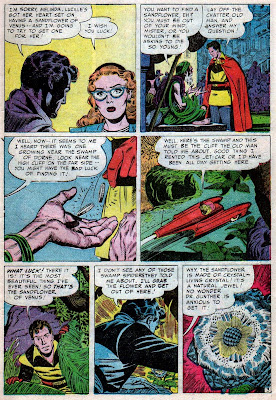
Mighty Man was a one-shot character in CrossGen Entertainment's fictional Sigilverse. He made his only appearance in Negation War #1 (2004). Mighty Man was a previously unknown Sigil-Bearer of the Superman archetype.
In Negation War, Mighty Man's planet was the first of many to be invaded by Charon and the Negation. His watcher/mentor (who was dispatched by Danik) took the form of a young male child. Mighty Man was not prepared for Charon's appearance and was killed by Evinlea (Danik's consort) shortly after the Negation arrived on his home planet. His watcher/mentor was also discovered by Charon and eventually sacrificed himself to destroy both the planet they were on and the orbiting Negation fleet; but this effort was mostly made to try and kill Evinlea of the First (whom it is supposed, would have posed a significant threat to Danik's forces (the First) in this universe).
The Sigil is a red-and-yellow mark which serves as the source of supernatural power for many Crossgen characters. The main characters of most titles possessed a Sigil, granting them a range of powers chosen by their personalities, desires, and fates.The red and yellow symbolized Houses Dexter and Sinister of The First (the gods of the Sigilverse). Accordingly, the colors represented Creation and Destruction, Selflessness and Selfishness, Love and Hate, and a number of other conflicts.
The creation and distribution of the Sigils was the work of two Atlantean sorcerers, Danik and Solusandra, who had ascended and become nearly omniscient and omnipotent. Though they pretended to have different motives early in the various Crossgen series, it was ultimately revealed in the end that they had created the Sigil-Bearers to serve as an elite force against the Negation, an evil empire invading from another universe. To that end, they bestowed Sigils, through various sorts of agents. Their agents took many forms, from a bird in Meridian, to a member of the Lesser Races in Scion, to a pair of hooded figures in Sojourn. Danik watched over each Sigil-Bearer in disguise, as one of the orange-eyed Mentors, and trained them for the coming war by involving them in smaller conflicts and forcing them to learn how to use their powers in new and different ways.
The Sigil-Bearers were, for the most part, unique to their respective worlds. Each was given a Sigil by an orange-eyed agent (or aspect) of the god-like Danik. The specific abilities of the Sigil varied greatly, according to the personalities and desires of its Bearer. Presumably, with the proper training and practice, any of the Sigil-Bearers could have used any aspect of the Sigil's power.
Mighty Man was never intended to become a major character of the Sigilverse, but his appearance did coincide with what is generally known about the Sigil-Bearers, that there were many of them and that each one’s powers were unique. Sigil-Bearers only very rarely met, until the events of the Negation War, in which the Sigil-Bearers were finally supposed to gather to battle against the Negation. Unfortunately, the bankruptcy of CrossGen Comics (declared in the middle of publishing this title), and the ending of the series about the Sigil-Bearers, remains unknown.
It was never revealed how many Sigil-Bearers existed. The appearance of Mighty Man in Negation War #1 and his subsequent death hinted at the existence of other Sigil-Bearers who had never appeared in any other Cross-Gen titles. A final count shows that at least 27 Sigil-Bearers were created in various CrossGen Comics. Given that each sigil-in-a-bubble seen on Solusandra's private world (see Solus #1) is a link to a different sigil-bearer, there are at least forty Sigil-Bearers and likely many more.
Mighty Man did not display high-level powers, nor did he display a common trait normally associated with Sigil-Bearers - the siphoning of a First's energy (although there is much that can account for this). Mighty Man's real name was Taylor and he had a wife, Carol & a son, Tommy. They lived together in Tri-City on their unnamed planet.
Above/Left: Mighty Man illustrated by Paul Pellitier.




















































